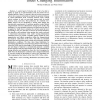42 search results - page 7 / 9 » Reacting, Planning, and Learning in an Autonomous Agent |
IAT
2010
IEEE
13 years 5 months ago
2010
IEEE
When its human operator cannot continuously supervise (much less teleoperate) an agent, the agent should be able to recognize its limitations and ask for help when it risks making...
PKDD
2009
Springer
14 years 1 months ago
2009
Springer
Probabilistic relational models are an efficient way to learn and represent the dynamics in realistic environments consisting of many objects. Autonomous intelligent agents that gr...
AROBOTS
2007
13 years 7 months ago
2007
— A central goal of robotics and AI is to be able to deploy an agent to act autonomously in the real world over an extended period of time. To operate in the real world, autonomo...
CEC
2010
IEEE
12 years 11 months ago
2010
IEEE
—Mobile cooperative sensor networks are increasingly used for surveillance and reconnaissance tasks to support domain picture compilation. However, efficient distributed informat...
ATAL
2010
Springer
13 years 8 months ago
2010
Springer
Learning, planning, and representing knowledge in large state t multiple levels of temporal abstraction are key, long-standing challenges for building flexible autonomous agents. ...

